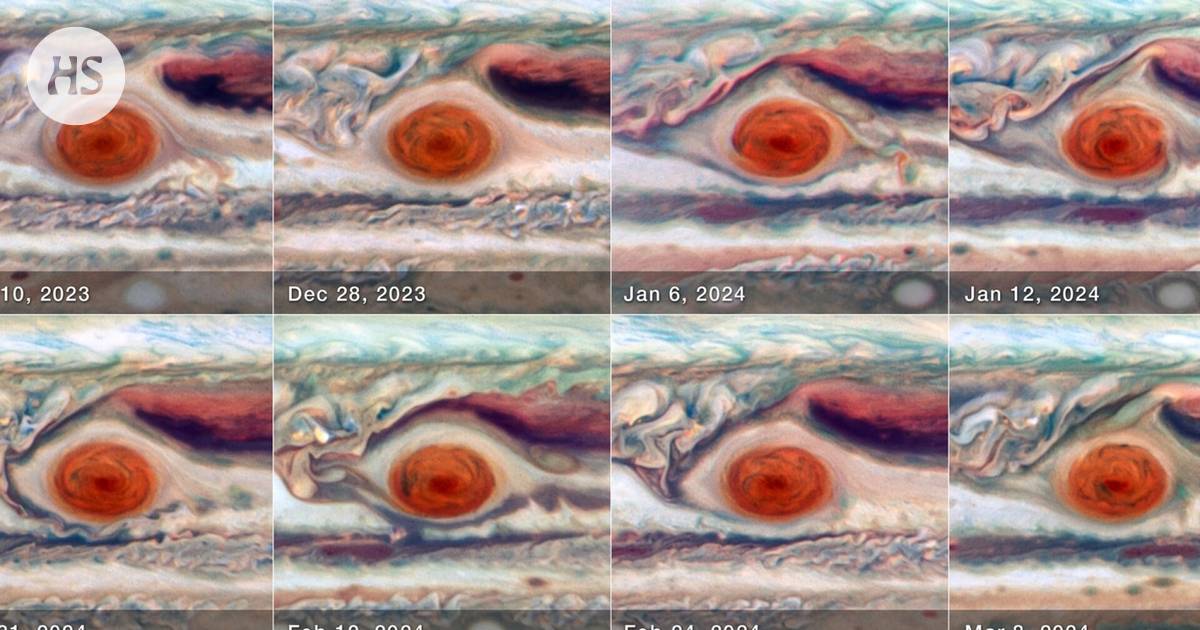The planets|Jupiter’s Great Red Spot is bigger than Earth. It has been studied for more than a hundred years. The Hubble Space Telescope tracked the comet for 90 days.
The summary is made by artificial intelligence and checked by a human.
For 90 days, the Hubble Space Telescope imaged Jupiter’s Great Red Spot in greater detail than ever before.
The pictures reveal that the speck swells and shrinks like a Stress Ball in the gust of storm winds.
The images and tracking of the comet may be useful as astronomers study the gas atmospheres of new distant exoplanets.
Pilkku has been monitored with various devices since 1831 and almost continuously since 1879.
Comma Jupiter’s gas atmosphere could easily swallow the Earth. It is the largest known storm in our solar system. Sometimes it is a frightening crimson.
Airmankos big red spot has also been called “planet Jupiter’s cyclops eye”. Although it is a really big storm, it is not visible to the naked eye.
A large red spot looms in the gas giant’s southern hemisphere near the equator. Its storm clouds can move over 400 kilometers per hour.
The speck is more than 16,000 kilometers wide, but not quite that high. The storm has been studied with various devices since 1831.
A comma changes began to be monitored regularly only by the US Space Administration In NASA’s Opal program in the 2010s. Opal regularly photographs the gas atmospheres of the planets in our solar system.
The space telescope Hubble also followed the comma very closely. From its photo series, it was revealed that the speck lives all the time under the pressure of storm winds.
Hubble abnormally followed the comet for no less than 90 days. The collection of images reveals how the dot changes from day to day from December 2023 to March 2024.
The shape of the comma is elliptical. It sometimes looks a little thinner or fatter. This transformation is still not properly explained.
One astronomer said that “a speck is like a big bowl of gelatin”. Of course, Jupiter’s gas ring is constantly changing it with violent winds.
Jupiter’s Great Red Spot is the largest storm in our solar system. It has been clearly visible in the southern hemisphere of the giant planet for at least more than 150 years.
Vortexes predicting movements is difficult.
It’s like trying to predict the swirls of cream poured into a coffee cup. At the outer edge of the gap, the gases make a full revolution in an estimated 4–6 days.
“We didn’t expect the whole speck to oscillate so visibly. It has not been identified before,” says the planetary scientist Amy Simon From NASA’s Goddard Space Flight Center in Maryland.
“If we look closely at the comma, we see that the comma changes every day,” says Simon In a NASA announcement.
A comma Followers predict that before long the comma will be rounded. At this time, the spot is also slowly shrinking.
Shrinkage started already at the end of the 19th century, he says The New York Times. However, the surrounding jet streams keep it in place all the time, Simon said.
At the same time, the dot moves slowly to the west, i.e. counter-clockwise. It orbits the entire planet in about 4.5 Earth orbits per day.
Pikku’s speed to the west speeds up and slows down in periods. This has been known for a long time, but it has not been explained.
Hubblen a close look at Jupiter may offer new clues about what kind of eddies exist on the surfaces of large exoplanets. Such have not yet been found on exoplanets, but the precision of the devices is constantly improving.
Tracking Jupiter’s red spot and other storms can also help scientists understand the meteorology of exoplanets.
Knowing about the biggest storm in the solar system can also help in tracking hurricanes on Earth.
Jupiter’s red spot monitoring was introduced In Annual Meeting of the Planetary Studies Division of the American Astronomical Society, Boise, Idaho.
A study on commas was published The Planetary Science Journal.
